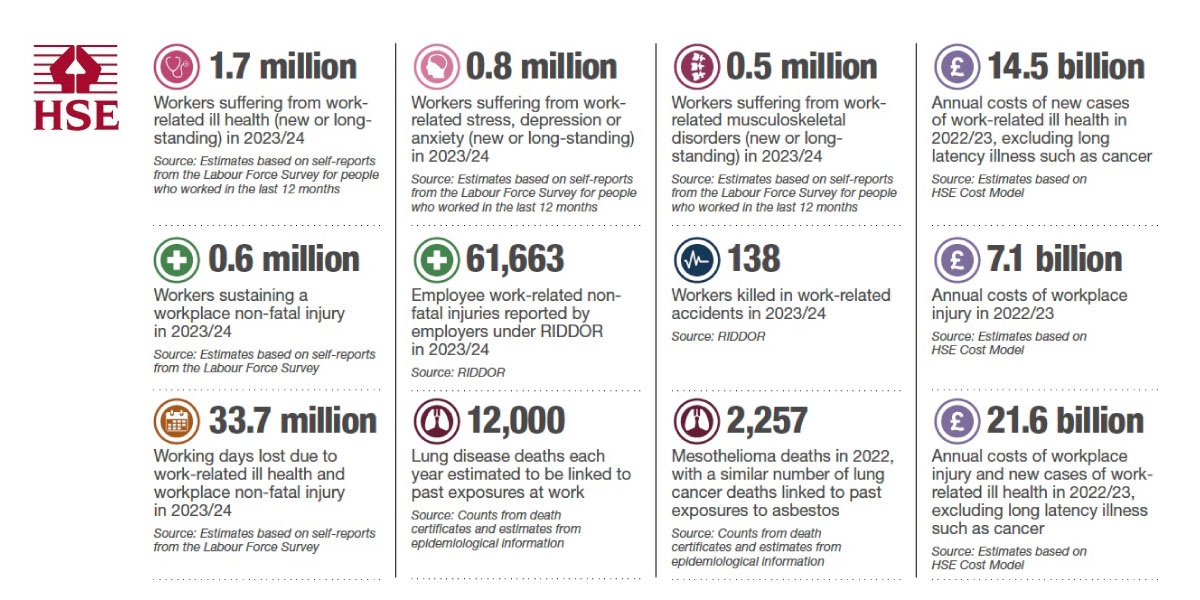The Health and Safety Executive (HSE) has released the 2024 statistics for workplace safety in Great Britain, and the figures are a stark reminder of the ongoing need for vigilance, education, and proactive measures in workplace health and safety.
These statistics highlight critical areas that every organisation and worker should be aware of, with implications for businesses across all sectors. Here’s a closer look at the key findings and what they mean for ensuring safer workplaces.
Key Figures: A Snapshot of 2023/24
- Work-Related Ill Health:
- 1.7 million workers suffered from work-related ill health.
- 776,000 workers experienced stress, depression, or anxiety linked to their work.
- 543,000 workers reported work-related musculoskeletal disorders.
- These figures translated to 33.7 million working days lost, demonstrating the massive impact on productivity.
- Workplace Injuries:
- 604,000 workers sustained a workplace injury, according to the Labour Force Survey.
- 61,663 injuries were reported under RIDDOR.
- Tragically, 138 workers were killed in workplace accidents.
- Asbestos-Related Risks:
- 2,257 mesothelioma deaths in 2022 were linked to past asbestos exposure, with additional cases of asbestos-related lung cancer and respiratory illnesses.
- Economic Costs:
- Workplace injuries and ill health resulted in an estimated £21.6 billion in costs during 2022/23.
What These Numbers Mean for Employers
The data reflects an urgent need for proactive measures to address workplace safety and health risks. Employers have a legal and moral responsibility to protect their workers, and these statistics highlight areas where improvement is vital.
1. Addressing Mental Health in the Workplace
Work-related stress, depression, and anxiety remain leading causes of lost working days. Employers should:
- Foster open communication about mental health.
- Provide access to resources such as Employee Assistance Programmes (EAPs).
- Offer training such as IOSH Managing Safely to equip managers with tools to reduce workplace stress.
2. Preventing Musculoskeletal Disorders (MSDs)
With over half a million workers affected by MSDs, organisations should:
- Conduct regular ergonomic assessments.
- Implement proper manual handling training.
- Review and improve workplace equipment and processes to minimise strain.
3. Mitigating Asbestos Risks
Although asbestos-related deaths are a legacy issue, the need for ongoing vigilance is clear. Employers in construction and refurbishment must:
- Conduct thorough asbestos surveys.
- Ensure workers receive asbestos awareness training, such as the UKATA Asbestos Awareness Course.
4. Reducing Workplace Accidents
With over 600,000 injuries reported, it’s essential to focus on accident prevention. Training is key, and courses like the CITB Health and Safety Awareness and NEBOSH General Certificate can empower workers and managers to identify and mitigate risks effectively.
Steps to Build Safer Workplaces
- Invest in Training: Equip your workforce with the skills and knowledge they need to stay safe. Consider courses like:
- IOSH Managing Safely
- NEBOSH General Certificate
- CITB Health and Safety Awareness
- Promote a Safety-First Culture: Lead by example and ensure safety is prioritised at every level of the organisation. Regular toolbox talks and risk assessments are vital.
- Monitor and Adapt: Stay informed about health and safety trends and update policies accordingly. The changing nature of work means risks must be continuously reassessed.
Moving Forward: A Call to Action
The statistics are a clear call to action for organisations to take workplace health and safety seriously. With proper training, policies, and a commitment to a safety-first culture, these figures can improve over time.
At Acadame, we are dedicated to Constructing Safety Together. Through a wide range of health and safety courses, we’re here to help organisations protect their workforce, reduce risks, and foster a safer environment for everyone.
Let’s work together to turn these numbers around. Explore our training courses today and make safety your organisation’s top priority.




